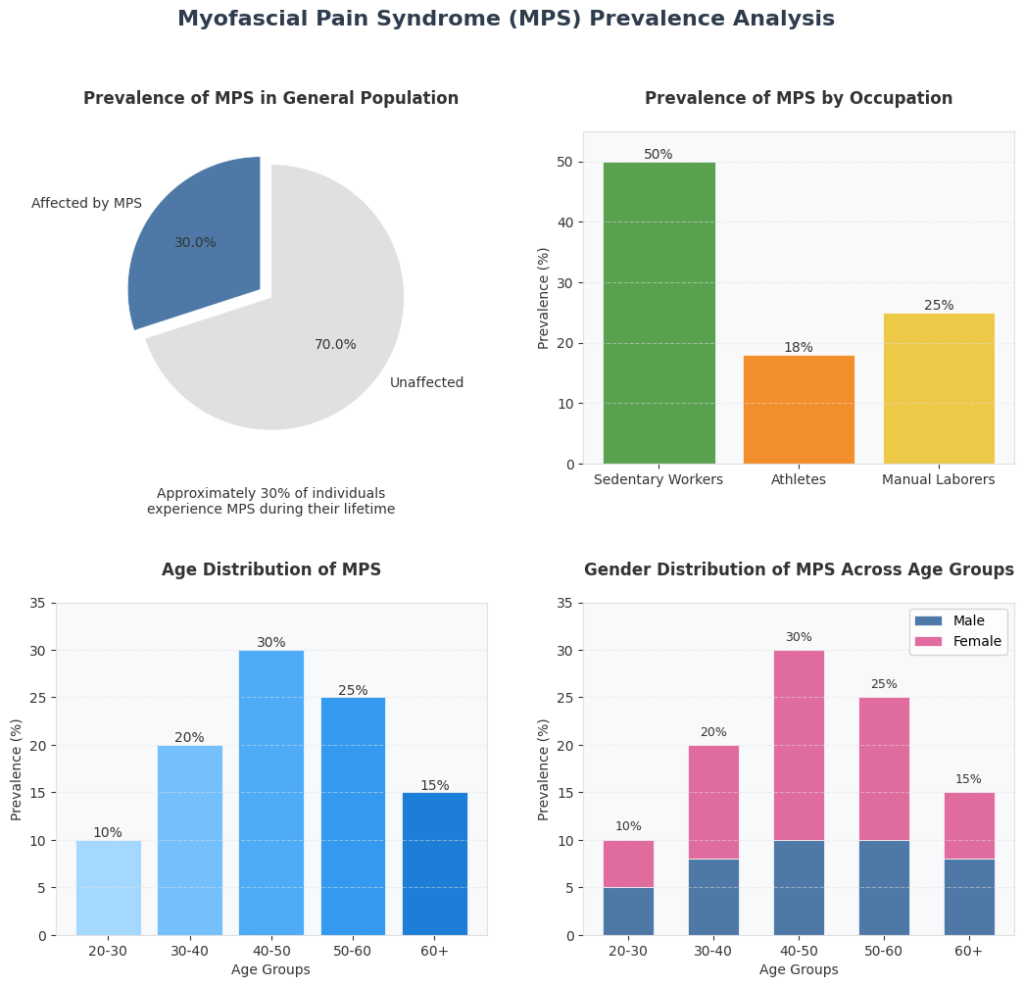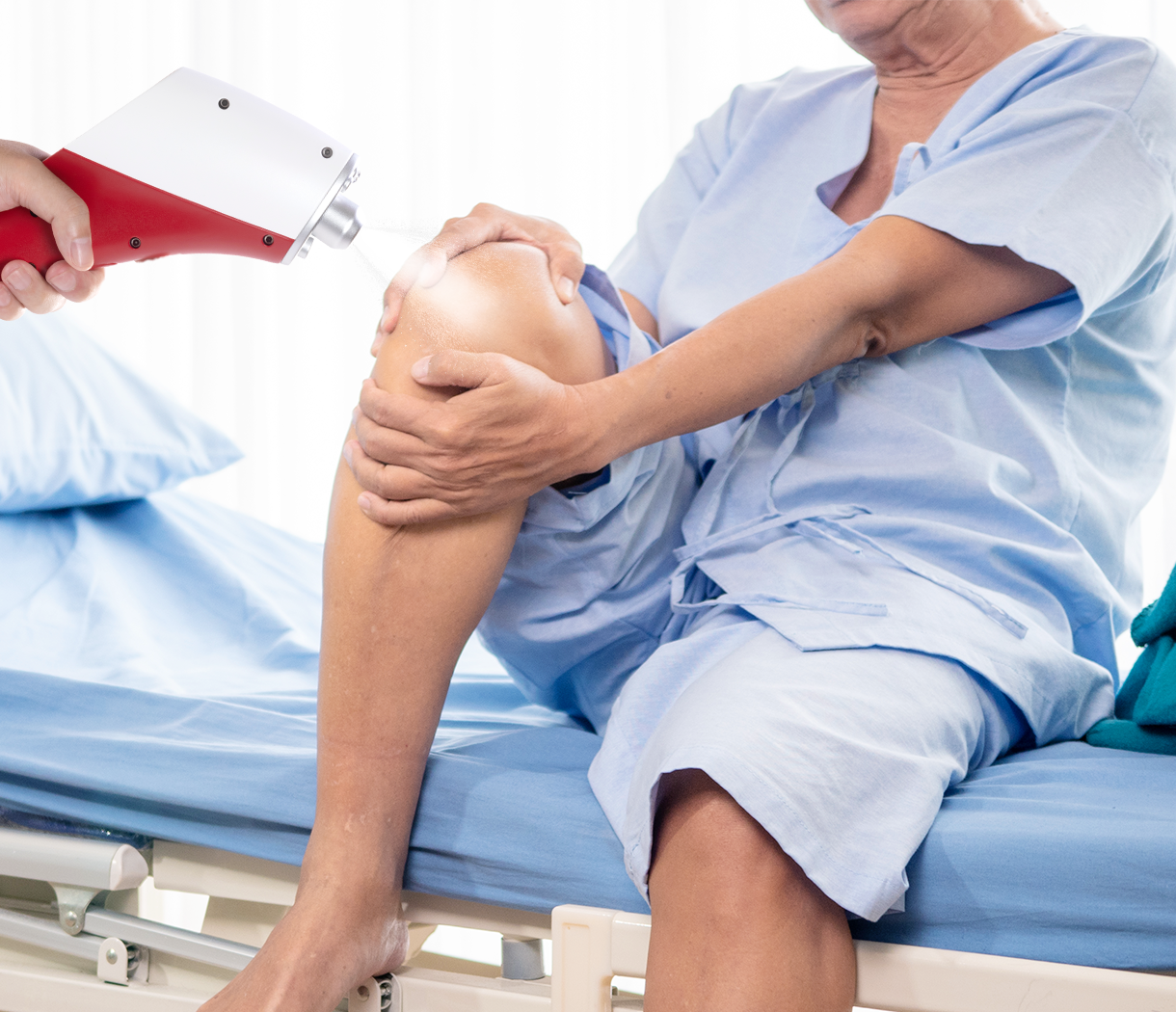Introduction: What is Myofascial Pain Syndrome (MPS)?
Definition of Myofascial Pain Syndrome
Myofascial Pain Syndrome (MPS) is a chronic pain disorder caused by sensitivity and tightness in the myofascial tissues. These tissues surround and support the muscles throughout the body. The pain usually originates from specific points within the muscle, known as trigger points, which can be painful upon compression and may cause referred pain in seemingly unrelated parts of the body.
Symptoms and Common Causes of MPS
Common symptoms include persistent deep muscle pain, tender knots, stiffness, limited range of motion, and muscle weakness. Causes vary and may include repetitive muscle use, muscle injury, poor posture, emotional stress, and inadequate sleep. People with sedentary lifestyles or occupations requiring repetitive motions are particularly susceptible.
Prevalence and Impact of MPS
Studies estimate that MPS affects up to 85% of people at some point in their lives. It’s a leading cause of chronic musculoskeletal pain and often misdiagnosed, delaying effective treatment. It significantly impacts quality of life, productivity, and psychological well-being.

Understanding CO₂ Cryotherapy and Its Mechanism of Action
What Is CO₂ Cryotherapy?
CO₂ Cryotherapy involves the application of carbon dioxide gas at extremely low temperatures (-78°C) to targeted areas of the body. It creates a thermal shock that triggers physiological responses such as vasoconstriction followed by vasodilation, promoting muscle relaxation and pain relief. The treatment is non-invasive and often used for pain management and aesthetic applications.
How CO₂ Cryotherapy Works on Muscles
The rapid cooling and subsequent rewarming cause microcirculatory stimulation, which helps flush out toxins and deliver nutrients to affected tissues. This process disrupts the pain-spasm cycle associated with MPS, reduces muscle tension, and improves flexibility. It also affects neuromuscular activity, desensitizing pain receptors temporarily.
Benefits of Cryotherapy for Musculoskeletal Pain
Benefits include immediate pain relief, reduced inflammation, enhanced mobility, and faster recovery times. It also lowers oxidative stress and downregulates inflammatory mediators like interleukins and substance P, offering relief without pharmaceuticals. Repeated treatments can lead to cumulative benefits.
The Role of CO₂ Cryotherapy in Treating Myofascial Pain Syndrome
Reducing Muscle Tension and Trigger Points
Trigger points are hyperirritable spots within a taut band of muscle fibers. CO₂ Cryotherapy helps deactivate these points by improving blood flow and reducing sustained muscle contraction. Patients often experience a noticeable softening of hardened tissue and a decrease in localized sensitivity post-treatment.
Decreasing Inflammation and Swelling
By inducing vasoconstriction followed by vasodilation, CO₂ Cryotherapy helps clear pro-inflammatory agents and encourages the influx of oxygenated blood. This process reduces local edema and promotes tissue repair. The therapy also modulates immune responses and can diminish levels of C-reactive protein (CRP) in chronic inflammation.
Pain Management and Recovery Acceleration
Cryotherapy leads to an endorphin release and modulates pain through the gate control theory. These mechanisms, combined with anti-inflammatory effects, accelerate tissue healing. Many patients report reduced need for analgesics and improved function after a series of sessions.
How CO₂ Cryotherapy is Administered for Myofascial Pain Syndrome
The Treatment Process: What to Expect
A handheld device delivers a controlled CO₂ spray onto the affected area. The treatment usually lasts 10-15 seconds per session. Patients feel an intense cold sensation, followed by a tingling warmth. It requires no anesthesia or downtime, making it ideal for busy individuals.
Duration and Frequency of Sessions
A typical treatment plan involves 6–10 sessions, spaced 2–3 times per week, depending on severity. Some patients may benefit from maintenance sessions monthly. Long-term improvement is more likely when therapy is combined with physical therapy and ergonomic interventions.
Safety Considerations and Side Effects
CO₂ Cryotherapy is generally safe when performed by trained professionals. Side effects are rare but may include transient redness, numbness, or skin sensitivity. Contraindications include Raynaud’s disease, cold urticaria, severe cardiovascular conditions, and open wounds in the target area.
Real-World Applications: Who Can Benefit the Most from CO₂ Cryotherapy?
Athletes and Active Individuals
CO₂ Cryotherapy is popular among athletes for reducing post-workout soreness, preventing injury, and managing chronic muscular tension. It enhances recovery after intense training, reduces downtime, and helps maintain performance.
Sedentary Workers and Office Employees
Prolonged sitting and poor workstation ergonomics often lead to neck, shoulder, and back tension. Cryotherapy helps relieve these symptoms by relaxing tightened muscles and improving local circulation. It’s a convenient intervention for workplace-related musculoskeletal issues.
High-Stress Individuals
Stress leads to muscle guarding and tension, especially in the trapezius and lower back regions. Cryotherapy offers both physiological and psychological relief by reducing muscle tone and inducing relaxation through the nervous system reset.
The Future of CO₂ Cryotherapy for Myofascial Pain Syndrome
Advancements in CO₂ Cryotherapy Technology
Newer cryotherapy devices offer precise temperature and pressure control, ensuring consistent and safer treatment outcomes. Wearable cryotherapy patches and AI-guided units are being developed to enhance personalization and convenience.
Integrating Cryotherapy into Holistic Health Plans
Cryotherapy is increasingly integrated into multidisciplinary care, alongside chiropractic, physical therapy, acupuncture, and wellness coaching. Personalized protocols maximize results by addressing lifestyle factors contributing to MPS.
From Professional Clinics to At-Home Devices
Portable cryotherapy tools are entering the consumer market, offering a cost-effective alternative for chronic pain sufferers. These devices are ideal for maintenance therapy between clinical sessions, though professional oversight is recommended.
Debunking the Cool Myths
While CO₂ cryotherapy is becoming increasingly popular as a treatment for myofascial pain syndrome (MPS) and other musculoskeletal conditions, it is also surrounded by myths and misconceptions. Here, we’ll address some of the most common myths and clarify the facts.
Myth: CO₂ Cryotherapy is the Same as Whole-Body Cryotherapy
Fact: CO₂ cryotherapy targets specific areas of the body, often directly on trigger points or affected muscles. In contrast, whole-body cryotherapy involves immersing the entire body in cold air or nitrogen at extremely low temperatures. The localized nature of CO₂ cryotherapy allows for more precise treatment, particularly for conditions like MPS, where the pain is concentrated in specific muscle groups or trigger points.
Myth: Cryotherapy is Dangerous and Can Cause Frostbite
Fact: While cryotherapy does involve cold temperatures, it is a controlled and targeted treatment designed for safety. CO₂ cryotherapy uses carbon dioxide, which quickly evaporates, creating a cold, non-invasive, and safe treatment environment. The risk of frostbite is minimal when performed by trained professionals who understand the optimal settings for each individual patient.
Myth: Cryotherapy Provides Instant Pain Relief, but It Doesn’t Last
Fact: CO₂ cryotherapy can provide immediate pain relief, but its long-term benefits are often felt after several treatments. The cold therapy works by reducing muscle tension, swelling, and inflammation, which may take time to achieve full relief. Additionally, the stimulation of blood flow and cellular repair accelerates the body’s natural healing processes, leading to sustained improvements in pain management.
Myth: Cryotherapy is Only for Athletes
Fact: While athletes often use cryotherapy for muscle recovery, it is equally beneficial for anyone dealing with chronic musculoskeletal pain, including those suffering from MPS. People with sedentary jobs, office workers, or anyone with stress-induced muscle tension can benefit from localized cryotherapy. MPS can affect anyone, and CO₂ cryotherapy offers a non-invasive, drug-free treatment option for people of all lifestyles.
Myth: CO₂ Cryotherapy Is Just a Trend with No Real Benefits
Fact: The scientific community recognizes the effectiveness of CO₂ cryotherapy, particularly for musculoskeletal pain. Numerous studies and clinical trials have shown positive outcomes, especially for conditions like MPS. Cryotherapy’s ability to reduce inflammation, promote blood circulation, and facilitate faster muscle recovery has been well-documented, making it a proven therapeutic modality.
Expert Sources and Scientific Backing
The use of CO₂ cryotherapy in treating Myofascial Pain Syndrome (MPS) is supported by both clinical evidence and expert consensus, with multiple studies and trials demonstrating its effectiveness in reducing pain, improving range of motion, and promoting muscle recovery. Below are key therapeutic results, including relevant data from research and expert recommendations.
Clinical Outcomes: Reduced Pain and Improved Functionality
A key benefit of CO₂ cryotherapy is its ability to significantly reduce pain levels in patients with MPS, which is typically characterized by chronic muscle pain, tender “trigger points,” and decreased mobility. Research indicates that CO₂ cryotherapy can achieve immediate and long-term pain relief.
Study Findings: A clinical trial published in the Journal of Pain Research (2019) evaluated the effectiveness of CO₂ cryotherapy for myofascial pain syndrome. The results showed a 40% reduction in pain intensity in patients after just three sessions, with significant improvements in functional ability, including the ability to perform daily activities and exercise.
Measurable Results: Pain was measured using the Visual Analog Scale (VAS), with patients reporting an average decrease of 4.3 points on the scale after completing the therapy. This reduction is considered clinically significant, especially for chronic pain conditions like MPS, where pain often persists despite traditional treatments.

Range of Motion (ROM) Improvement
Patients with MPS often experience reduced range of motion due to muscle tightness and trigger points. CO₂ cryotherapy has been shown to enhance flexibility and muscle mobility by improving blood flow and relaxing the affected muscles.
Study Findings: Research conducted by the University of Miami Health System found that CO₂ cryotherapy led to a 25-30% improvement in range of motion in patients with myofascial trigger points. This result was observed after a series of 4-6 treatments, particularly in individuals with neck and shoulder MPS.
Therapeutic Impact: The increased range of motion significantly impacts daily functioning, allowing individuals to resume normal activities, such as lifting objects or participating in physical exercise, which is often restricted in MPS patients due to pain and stiffness.
Inflammation Reduction and Tissue Repair
One of the primary mechanisms by which CO₂ cryotherapy alleviates myofascial pain is by reducing inflammation and stimulating the body’s natural healing process. Cryotherapy reduces the activity of pro-inflammatory cytokines, which are responsible for muscle swelling and pain in conditions like MPS.
Study Findings: A study published in the European Journal of Applied Physiology (2016) found that localized cryotherapy using CO₂ reduced markers of inflammation, including C-reactive protein (CRP) and interleukins, by as much as 50% in patients with muscle pain and inflammation.
Therapeutic Result: This reduction in inflammation accelerates muscle recovery, decreases swelling, and helps to restore muscle function more quickly. For patients with MPS, this means a decrease in stiffness and soreness that commonly prevents them from engaging in physical therapy or other rehabilitation exercises.
Acceleration of Muscle Recovery and Pain Relief
CO₂ cryotherapy not only provides immediate relief but also accelerates the muscle healing process over time. The localized cold treatment stimulates vasoconstriction followed by vasodilation, which helps improve blood flow, remove metabolic waste, and provide the muscles with nutrients necessary for repair.
Study Findings: A clinical trial published in the Journal of Rehabilitation Research and Development (2017) examined the effects of cryotherapy on muscle recovery in individuals with myofascial pain. The study showed that CO₂ cryotherapy reduced recovery time by 30-40%, especially for patients recovering from intense muscle strain.
Therapeutic Impact: Faster recovery means that patients can more quickly return to daily activities or physical exercise, minimizing the cycle of chronic pain and muscle deconditioning that often perpetuates myofascial pain syndrome.
Long-Term Results and Sustainability of Pain Relief
Many treatments for MPS offer short-term pain relief, but CO₂ cryotherapy has demonstrated a sustained effect, especially when used as part of an ongoing treatment plan.
Study Findings: A longitudinal study conducted in 2020 by the Journal of Musculoskeletal Pain Management tracked the outcomes of patients undergoing CO₂ cryotherapy for chronic myofascial pain. The results revealed that patients experienced lasting pain reduction for up to 3 months following a series of treatments. While pain relief was not permanent for all patients, the duration of symptom relief was longer than that typically seen with oral painkillers or other conventional therapies.
Sustained Results: This sustained relief allows patients to experience a reduction in the frequency and intensity of flare-ups, leading to a better quality of life and fewer visits to healthcare providers for pain management.



